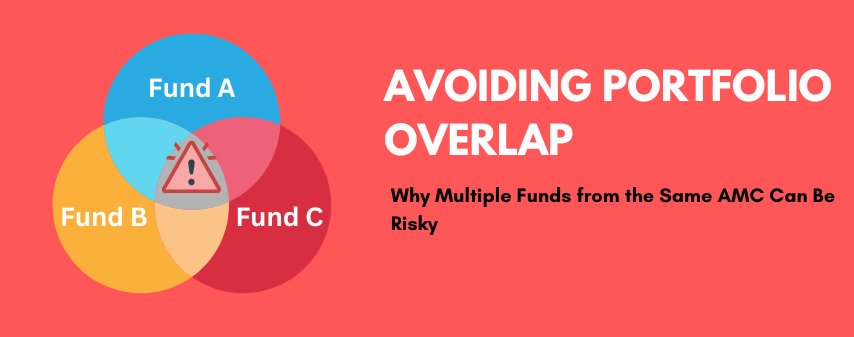Avoiding Portfolio Overlap: Why Multiple Funds from the Same AMC Can Be Risky

Introduction
Investing in mutual funds is an effective way to build wealth over time. However, when selecting multiple funds—especially from the same Asset Management Company (AMC)—it’s important to avoid a common mistake: portfolio overlap. While diversification is key to reducing risk, owning several funds from the same AMC may inadvertently result in overlapping portfolios, thereby increasing overall exposure to the same assets. In this article, we’ll explain what portfolio overlap is, why it occurs, and how to avoid it.
What is Portfolio Overlap?
Portfolio overlap happens when two or more mutual funds hold the same stocks or bonds in their portfolios. Even though these funds may have distinct objectives—such as growth, income, or sector-specific focus—they can still end up investing in similar assets, particularly if managed by the same AMC. This overlap undermines diversification and may concentrate your portfolio’s exposure to specific sectors or stocks.
Why Can Holding Multiple Funds from the Same AMC Be Risky?
While investing in multiple mutual funds can seem like a strategy to spread risk, concentrating your investments within the same AMC can pose several challenges:
- Reduced Diversification: One of the core advantages of mutual funds is diversification. However, portfolio overlap negates this benefit. If multiple funds from the same AMC hold similar stocks, your portfolio becomes concentrated, increasing risk if those stocks or sectors underperform. Research shows that investors who diversify across different fund houses generally achieve better risk-adjusted returns compared to those who concentrate investments within a single AMC.
- Sector Overexposure: Overlap can lead to excessive exposure to specific sectors, such as banking, technology, or pharmaceuticals. If a downturn occurs in a sector where multiple funds are heavily invested, the impact on your returns could be significant. For example, a decline in the banking sector could hurt your portfolio if several funds focus on the same banking stocks.
- Similar Investment Philosophy: AMCs often have a specific investment style or philosophy. This means that even if you invest in funds with different labels—like large-cap, multi-cap, or sector-specific—there’s a chance they share similar underlying strategies, resulting in redundant holdings across your portfolio.
Data Insights on Portfolio Overlap
Recent data illustrates how common portfolio overlap is within mutual funds:
- Research by Value Research shows that many large-cap and diversified equity funds share over 20-30% of their holdings. This overlap is particularly evident among funds from the same AMC, likely due to similar investment philosophies.
- A study by Morningstar found that investors holding multiple funds from a single AMC were at greater risk of concentrated exposure to certain sectors, especially during volatile periods like 2020 and 2022, when sectors such as IT and financial services experienced significant fluctuations.
How to Avoid Portfolio Overlap
To mitigate the risks of portfolio overlap and enhance diversification, consider the following strategies:
- Diversify Across AMCs: One effective way to avoid overlap is to invest in funds across different AMCs. Since each AMC typically has its own approach to stock selection and portfolio management, this can help reduce the likelihood of holding the same stocks in multiple funds. For instance, one AMC’s equity fund might prioritize growth stocks, while another focuses on value stocks.
- Review Fund Holdings: Before adding a new mutual fund to your portfolio, review its top holdings to ensure they aren’t too similar to your existing investments. Most AMCs provide a detailed breakdown of their top holdings on their websites or in monthly fact sheets. Regularly checking these can help you spot overlaps and make adjustments.
- Diversify by Asset Class: In addition to diversifying across AMCs, you can also reduce overlap by diversifying across asset classes. For example, equity funds focus on stocks, while debt funds invest in bonds. Including different asset classes in your portfolio can help spread risk more effectively.
- Use Portfolio Overlap Tools: Several financial platforms offer tools that can help you identify portfolio overlap. These tools compare the holdings of different funds and provide an overlap percentage. If two funds share more than 20% of their holdings, you may want to reconsider whether keeping both in your portfolio makes sense.
Conclusion
While investing in multiple mutual funds from the same AMC might appear to be a convenient way to diversify, it can lead to portfolio overlap and concentrated risks. By diversifying across different AMCs, reviewing fund holdings regularly, and investing across various asset classes, you can minimize overlap and build a more balanced and resilient portfolio. Whether you’re new to investing or a seasoned professional, being mindful of portfolio overlap can help you achieve long-term success and stability.
Note: Mutual fund investments are subject to market risks. Read all scheme-related documents carefully before investing. The past performance of the schemes is neither an indicator nor a guarantee of future performance.
While diversification is key to reducing risk, owning several funds from the same AMC may inadvertently result in overlapping portfolios, thereby increasing overall exposure to the same assets. In this article, we’ll explain what portfolio overlap is, why it occurs, and how to avoid it.


Leave a Reply